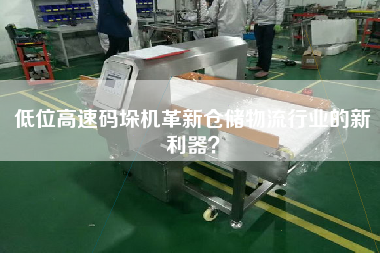With the continuous development of the logistics industry, the efficiency and accuracy of warehousing logistics has become the focus of attention. As an important equipment in warehousing and logistics, the palletizer has become a sharp weapon to improve efficiency and accuracy. Now, with the emergence of low-level high-speed palletizers, the warehousing and logistics industry will usher in another innovation.
I. advantages of low-level and high-speed palletizers
1.1 High efficiency

Compared with the traditional palletizer, the low-speed palletizer is faster and more efficient. It can complete the palletizing of a large number of goods in a short time, which greatly improves the efficiency of warehousing and logistics.
1.2 High accuracy
The low-level high-speed palletizer adopts advanced visual recognition technology, which can accurately identify the position and direction of the goods, so as to achieve accurate palletizing. This not only improves the accuracy of warehousing and logistics, but also avoids the damage of goods in the process of transportation.
1.3 strong adaptability
Low-level high-speed palletizer can adapt to different types and specifications of goods, so as to meet the needs of different customers. It can be automatically adjusted according to different palletizing requirements to achieve multi-variety and small batch production.
Operation steps of low-level and high-speed palletizer
2.1 Storage of goods
First of all, the goods are transported to the warehouse and stored in the warehouse. When entering the warehouse, the relevant information of the goods needs to be input into the system for subsequent operation.
2.2 sorting of goods
Then, the goods are sorted, and different types and specifications of goods are placed in different areas. This is beneficial to the subsequent palletizing operation.
2.3 palletizing of goods
After transporting the goods to the palletizing area, start the low-level high-speed palletizer and operate according to the instructions in the system. The low-speed and high-speed palletizer can automatically adjust according to the information of the goods to achieve fast and accurate palletizing.
2.4 delivery of goods from the warehouse
After completing the palletizing, transport the goods to the out-of-warehouse area and carry out the out-of-warehouse operation. When leaving the warehouse, the relevant information of the goods needs to be input into the system for subsequent operation.
Third, the application scene of low-level high-speed stacker.
Low-level high-speed palletizer is suitable for a variety of warehousing and logistics scenarios, especially for enterprises that need a lot of palletizing, it is a very practical equipment. Here are some applicable scenarios:
3.1 E-commerce warehousing
With the continuous development of e-commerce industry, the scale of e-commerce warehousing is also expanding. Low-level high-speed palletizer can quickly and accurately handle a large number of e-commerce goods and improve the efficiency of warehousing and logistics.
3.2 Food warehousing
Food warehousing has very high requirements for the safety and hygiene of the goods. The low-speed palletizer can accurately handle the food goods and ensure the safety and hygiene of the goods.
3.3 Medical warehousing
Pharmaceutical warehousing requires very high accuracy and accuracy of the goods. The low-speed palletizer can automatically adjust according to different drug specifications to achieve accurate palletizing.
IV. Conclusion
The emergence of low-level and high-speed palletizer has brought new opportunities and challenges to the warehousing and logistics industry. It can improve the efficiency and accuracy of warehousing logistics and bring more business opportunities and profits for enterprises. It is believed that in the future development, low-level high-speed palletizer will play a more important role in the warehousing and logistics industry.
